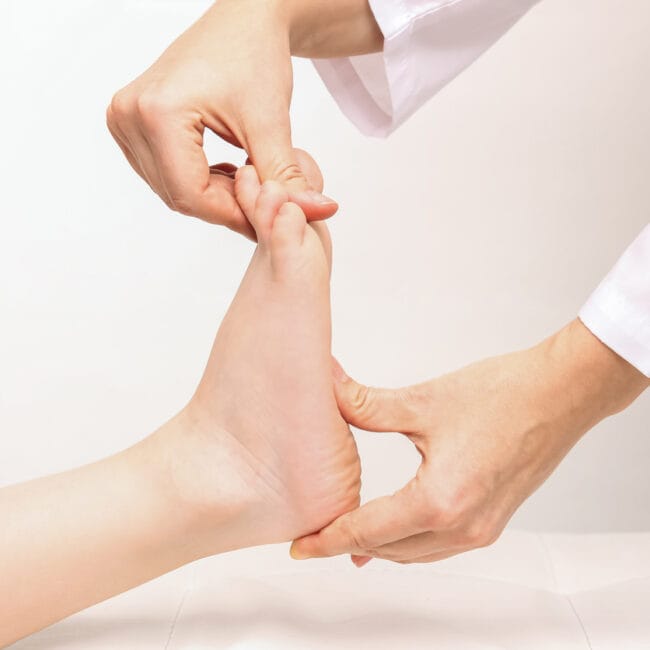Gout is a form of inflammatory arthritis that commonly affects the joint of the big toe. Joints become inflamed, heated and can be tender and very painful – even during sleep. Typically signs and symptoms are acute and come on without warning, known as a “gout attack”. Pressure on the joint will like likely become unbearable; even the touch of a blanket may aggravate pain. Some individuals may never have another “gout attack”, however it is likely that the acute episode will occur again.
Once known as the “disease of kings”, the condition was previously associated with wealthy males who consumed foods high in protein (Nuki and Simkin, 2006). Protein (i.e. meat, fish, dairy, eggs, etc.) is made up of small chains containing amino acids, which are further divided into purines and pyrimidines, depending on their shape.
These chemical compounds are naturally excreted through urine, however high amounts of purines (e.g. in duck, bacon, turkey, seafood, sunflower seeds) are unable to be excreted from the body and can lead to a build-up of uric acid in the blood. Gout arises when this excess uric acid is formed into crystal and is then deposited in the joints.
Symptoms Of Gout
As like many other conditions, over time these crystals build up in joints, and painful inflammation can arise when crystals rub off the bones within the joint and an acute “gout attack” can occur. The attack will worsen over a period of 12 hours and begin to ease over the following 10 days.
Progression Of Gout
1. Symptom free
High uric acid levels
Crystal formation in joints
Asymptomatic hyperuricemia
2. Acute gout attack
Typically a night-time occurrence
Joint swelling and pain
Worsens over 12 hours
Usually eases in 10 days
3. Interval Gout
Acute attack has ended
Pain free, with normal joint movement
Low grade inflammation persists
Can progress to acute attack
Joint damage possible
May never occur in some individuals
4. Chronic Gout
Gout attacks occur frequently
Permanent joint damage
Constant pain
Requires surgical intervention
Risk Factors Of Gout
Family history can play a role, and the condition can typically affect more men than women. Men are three to four times more likely to develop gout than women – this is because their uric acid levels rise during puberty. During menopause, women experience a similar, albeit smaller, rise in their uric acid levels. This explains why the onset of symptoms usually occurs later in women than it does in men.
Lifestyle factors, such as overweight and obesity can play a part, as can consumption of alcohol and purine-rich foods. Some medications, such as diuretics or aspirin, can also have an impact – please note that your doctor will advise of high-risk factors.
Treatment For Gout
Some medication can help with acute gout attacks, however there are some lifestyle tips you can also follow.
Ice and elevation may help to reduce pain and inflammation
Hydrate with water and rest as much as possible
Consult with your GP for further advice, who may help prescribe steroids, or non-steroidal anti-inflammatories (NSAIDs) at a high dose for pain
When it comes to footwear, seek shoes that have space in the toe box. This will reduce excessive contact and reduce pain. A soft, customised orthotic may also offer support to the foot, whilst relieving stress on the big toe (Ipfh.org, 2020).
Gout is affected by nutrition, and making the right dietary choices can help manage uric acid levels and reduce flare-ups. For expert guidance from our dietitians, visit our nutrition hub here.
How To Prevent Gout
Maintain a healthy diet and active lifestyle
Decrease intake of high purine foods, limiting alcohol consumption
Include a low dose non-steroidal anti-inflammatory drug if necessary (Singh, Reddy and Kundukulam, 2011).
We recommend consulting with your GP before taking any medication and working with our team to manage gout symptoms. For further reading from our team of dietitians, you can visit here.
References
Arthritis.org. (2020). Gout. [online] Available at: https://www.arthritis.org/diseases/gout
Neogi, T., Chen, C., Niu, J., Chaisson, C., Hunter, D.J. and Zhang, Y., 2014. Alcohol quantity and type on risk of recurrent gout attacks: an internet-based case-crossover study. The American journal of medicine, 127(4), pp.311-318.
Nuki, G. and Simkin, P.A., 2006. A concise history of gout and hyperuricemia and their treatment. Arthritis research & therapy, 8(S1), p.S1.
Saag, K.G. and Choi, H., 2006. Epidemiology, risk factors, and lifestyle modifications for gout. Arthritis research & therapy, 8(1), p.S2.
Singh, J.A., Reddy, S.G. and Kundukulam, J., 2011. Risk factors for gout and prevention: a systematic review of the literature. Current opinion in rheumatology, 23(2), p.192.
HSE.ie [online] https://www.hse.ie/eng/health/az/g/gout/treating-gout.html















